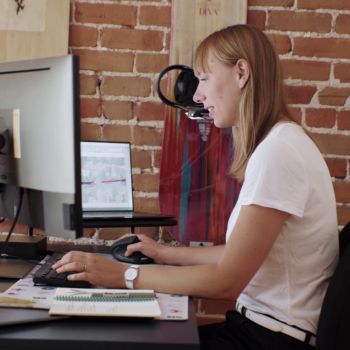Many people would like to continue working remotely once the pandemic is over. Committed to responding to the needs of its some 2,600 employees, CIMA+ is currently working in close collaboration with them in order to introduce a hybrid work policy. This flexible and innovative policy will be rolled out in the near future.
 The new work model is built around three guidelines, which together constitute the three pillars of its success: adapting the policies and procedures for human resources management; making computer equipment that is appropriate to each situation available to its staff; reorganizing the work spaces at about thirty of the consulting engineering firm’s offices.
The new work model is built around three guidelines, which together constitute the three pillars of its success: adapting the policies and procedures for human resources management; making computer equipment that is appropriate to each situation available to its staff; reorganizing the work spaces at about thirty of the consulting engineering firm’s offices.
“Without the health crisis, this major reassessment would probably never have happened,” asserts David Murray, Senior Vice President of Energy and Resources at CIMA+. “In the past few years, we have proven that an organization like ours can indeed operate in hybrid mode.” David Murray steers the company’s committee on hybrid work, which was set up as soon as the first upheavals of COVID-19 were felt. “It was initially a case of setting up a telework committee. We realized, however, that most of our teams were in actual fact already working on hybrid schedules,” he adds.
Turning back at this point is out of the question. Moreover, an internal consultation showed that approximately 80% of employees would like to continue working remotely a few days a week. “Maintaining this flexibility is now part of the expectations of our talent. This also holds true for external applicants we wish to attract to our organization, because this question is soon raised in discussions during the selection process,” says Katia Millaire, Director of Business Partners in the human resources department at CIMA+ and member of the committee on hybrid work. “An employer of choice must now offer flexibility,” she adds, when talking about a positive change in attitudes.
Properly understanding needs
This revolution in working methods comes with its share of challenges; respecting the pace at which each person evolves is one of them. This therefore requires flexibility and agility when setting up a hybrid work model. “We don’t claim to have met all the needs from the outset, but our strength lies in our ability to improve. The realities are not the same from one individual to the next, for example,” says Katia Millaire. That’s why each employee is invited to think about the work option that is best suited to them, while bearing in mind the needs of the organization, and then discuss it with their manager so as to reach an agreement which will meet the expectations of all involved.
Another challenge is ensuring that the on-premises work spaces – in other words at the office – are in line with this new reality. “Gone are the days of assigned workstations. Work environments today need to be designed according to the tasks that are performed there,” explains Caroline Turgeon, Senior Project Manager at CIMA+ and the person in charge of the retrofit of the firm’s offices. Among other things, an assessment of the square metres and number of seating positions to provide for staff guides the work being carried out in collaboration with the IT team responsible for the IT infrastructure.
This transformation is already well underway at the Montreal office, where its 570 employees recently started enjoying their newly-renovated work spaces. There are different types of environments, from non-assigned workstations to private lounges for work meetings, as well as soundproof booths for phone calls and videoconferences, rooms designed for joint meetings and library-style quiet work spaces. “As we don’t know how frequently employees will be coming into the office, we work closely with our team managers,” Caroline Turgeon points out.
A blank page
It goes without saying that consultation is key to the success of this work model evolution. Given the changes being made and resistance that such changes can sometimes come up against, this approach enables employees in the various work teams to express their concerns, feel that they are being heard and play a part in this evolution. “At CIMA+, we grow and develop together in order to ensure that our work model of tomorrow is innovative, flexible and focused on respect,” Katia Millaire explains. The new hybrid work policy will be rolled out in the coming months.
In the meantime, managers will be trained and equipped to facilitate the hybrid work model’s implementation. “Among other things, they’ll have access to online training on our CIMA+ Campus to familiarize themselves with the key principles of the hybrid work policy. Employees will then be able to read its contents and sign an agreement, which we hope will be to their complete satisfaction,” she says in conclusion.
CIMA+ sees this hybrid work model as an opportunity to provide all its employees with better working conditions, while fostering commitment and ensuring the well-being of its talent.